





|
|
 |
 |
 |
 |
 |
 |
| CLICK HERE for larger images and descriptions of these thumbnails. | |||||
|
HOME PAGE |
PRESS COVERAGE INDEX |
OUR PROGRAMS |
OUR COLLECTIONS |
PRINTING GLOSSARY
|
RADIO NATIONAL NETWORK (AUSTRALIAN BROADCASTING CORPORATION)
 RADIO NATIONAL IS HEARD IN MELBOURNE ON 621 AM AND THROUGHOUT AUSTRALIA AND ON THE NET AT http://www.abc.net.au/radio/listenlive.htm. |

AT THE MUSEUM |
|
THIS PAGE REFERS TO AN ITEM ABOUT THIS MUSEUM, BROADCAST ON THE MEDIA REPORT THE ITEM IS BELIEVED TO BE STILL AVAILABLE AS TRANSCRIPT (TEXT) OR AUDIO FROM MELBOURNE MUSEUM OF PRINTING WAS FEATURED IN AN 8-MINUTE ITEM, WITHIN THE 30 MINUTE PROGRAM. NOTE: ALL TEXT AND PHOTOGRAPHS ARE COPYRIGHT. All intending users please see our copyright notice page. | |
The Media Report visits the Melbourne Museum of PrintingTHESE PICTURES AND TEXT RELATE TO THE PROGRESSION OF THE MEDIA REPORT ITEMLast updated 05 OCTOBER 2009 | ||
ABC personality Antony Funnell introduced the Museum item with a ''mystery sound'', asking his listeners to guess what it could be. It was in fact the complex set of sounds of the Linotype hot-metal typesetting machine. (Museum founder and curator) Michael Isaachsen fell in love with the processes of typesetting and printing at the age of 9 or 10, when roaming the streets of Adelaide city, he discovered printing shops and particularly the Linotype machines which made solid lines of type that could be used as a stamp. Michael's Dad let him buy a small desktop printing press at the age of 11. The press along with type, paper and inks, were used in Michael's bedroom all his teen years. These little presses were not uncommon for hobbyists. They used the same kind of hand-set or Linotype typesetting as commercial presses and could print cards and tickets, letterheads and small flyers with professional results. |
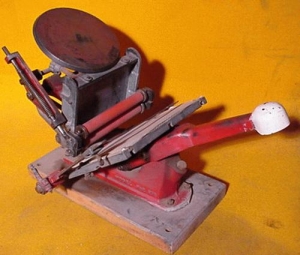 | |
Printing of text took over from hand-written text in the period 1450 to 1550. It started when one Johannes Gutenberg invented a way to make unlimited quantities of uniformly sized letters (usually called type). Gutenberg was a jeweller by trade and he used his skill to cut, file or grind a piece of steel to make a punch of each required character. The punches are 'male' and wrong-reading (so they could print a right-reading character). The punch would print its character only for testing: when perfectly formed, it would be punched into a slip of softer metal (probably copper in those days) to produce a matrix. The matrix is 'female' and right-reading. In conjunction with a typecasting mould [mold in US] each matrix could then be used to produce those unlimited quantities of uniformly-sized types. Each type is an exact replica of the punch, although on a rectangular body. A complete fount [font in US] of type may contain 90 or more different letters, figures, punctuation [points in printer's terms], ligatures and signs, and a total of hundreds or thousands of individual types, all of one size of one typeface. A fount is usually stored in a typecase (or a pair of typecases), from where the compositor (typesetting person) selects them one-by-one to assemble each line of text. The lines are assembled in the hand-tool called a stick (or composing stick) and then transferred a few lines at a time into a galley, a special tray with one open edge, until a page or 'take' is completed. After proofing (printing a single copy from the page of type for checking purposes) and correcting errors, the pages find their way into a printing press. There, ink is applied to the surface of the type and a sheet of paper is pressed onto it to receive the impression of the text. This process, whether printed by hand or automatic press, and whether the type is composed by hand or newer systems, is described by the name Letterpress or letterpress printing. Click here for more pix on hand-set movable type. |

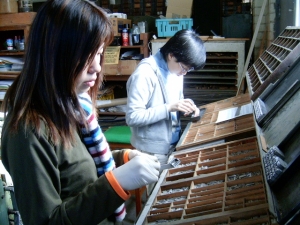
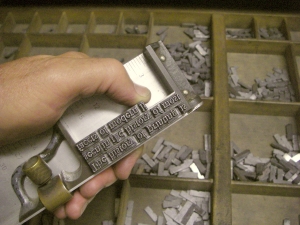
| |
The Linotype that so fascinated the schoolboy was first introduced around 1890 and taken up quickly by newspapers around the world. Melbourne and Sydney papers got theirs around 1895. By the 1950's most printing establishments were using Linotype or similar systems. Trade typesetting houses provided the service of such machines for printers who didn't have one or who needed extra capacity at times. The Linotype produces type in the form of bars ('slugs') with line of letters cast into one edge. As the operator types on the keyboard little brass matrices 'mats' assemble. Each mat has the (female) impression of a letter impressed into its edge. When the hot-metal pump fills the mould, the slug takes the letter-forms from the whole assembled line. The machine then sorts the mats automatically back to their correct channels in the 'magazine'. Each magazine carries a complete 'fount' [ font in US ] of mats of one size of one typeface. There may be up to 1200 mats in a fount. The output of the Linotype is a column of lines, which although more convenient to handle, are identical in use to a column of hand-set type. Click here for more pix on the Linotype System. |
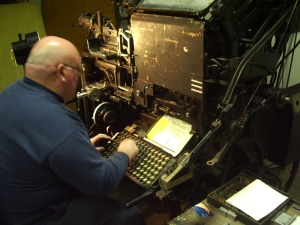
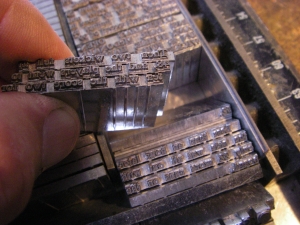 | |
The Melbourne Museum of Printing has one of the most comprehensive collections of print-related machinery, equipment, artefacts and documents in the world. Unfortunately, unlike most other such museums, it has to pay rent for its premises and receives no assistance from government or industry towards these costs. The Museum was closed from 1998 to 2003 and had no revenue but still had to pay the storage and transport costs. There is a substantial shortfall in revenue since the closure and reopening, and this is being made up by a small number of dedicated individuals borrowing (probably more than they can afford) to prevent loss of the collection. The present museum site is too small to accommodate all the classes and other visitors and the off-site storage is very large and spread over a number of nearby sites. WHAT'S IN THE COLLECTION ? The collection of artefacts and documents is the repository for the only substantial body of work of the printing industry of the twentieth century in the world. These chronicle the day-to-day work of several dozen printeries in the last decades of letterpress and the first decades of offset lithography. It contains tens of thousands of standing typesettings which are jobs set up in type and not broken up after printing. These represent the work of hundreds of craftsmen and reflect the business of thousands of print customers, mainly businesses that closed decades ago. It contains tens of thousands of engravings, which are the drawings and photographs, converted to letterpress format as blocks, that were used to illustrate all manner of documents. It contains thousands of artwork, negatives and plates, which are the vehicles of printing jobs under the 'new' system of printing which ousted letterpress in the decades from 1950 onwards. It contains thousands of documents that relate to the placing of orders by clients, the costing and progressing of orders and examples of completed work. The collection of typesetting facilities includes sufficient of many kinds of item to put together a fair representation of the working environment of larger printers and publishers, especially their composing rooms. Again, this is believed to be a unique quality of this Museum. Click here for more pix on the Museum's Collection. |
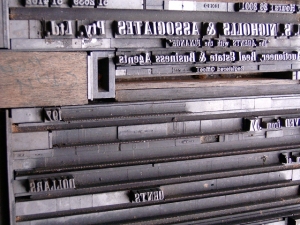
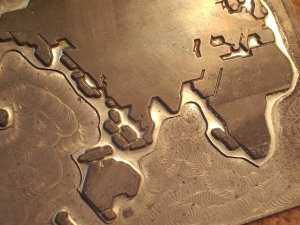
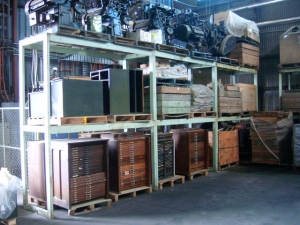
| |
Although the Museum's main venue is somewhat cramped, it is a lively place. Typesetting is active each open day, by hand and Linotype and other systems as are printing presses for posters, souvenirs, books, even wedding invitations. Many school teachers and university lecturers bring their classes of students (of graphic design and related subjects) to the Graphic Students' Workshop. This five-hour workshop enables students who will only ever use computers for their professional work to see what came before and how the principles set down by Gutenberg and others, 500 years ago, still apply. The Roots of Printing Workshop is offered for PD (professional development) of those in the industries of printing, advertising, publishing, etc. This eight-hour workshop has substantial hands-on content. Community groups such as Rotary and Probus, retired persons, even a club of car restorers, have enjoyed a group tour. Due to limitations, the Museum has not widely advertised to the general public but those who find out are nevertheless very welcome. ARTISTS' ACCESS STUDIO Those who would like to do some practical printing or just experiment with type and presses are welcomed to this facility. Museum volunteers do not usually print for visitors or clients, rather the clients are shown how to typeset and print and produce their own work. VOLUNTEERS PROGRAM Museums of this nature could not function without volunteers. At this stage there are no paid staff. Click here for more details on the Museum's Activities. |

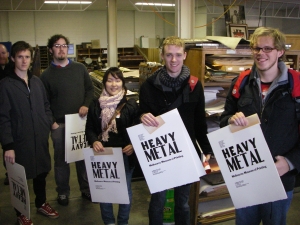
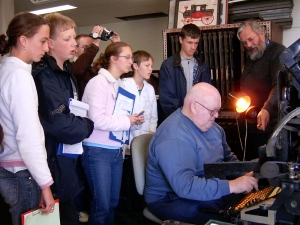 LAURIE DEMONSTRATES THE LINOTYPE WHILE MICHAEL (RIGHT) POINTS OUT THE FEATURES. | |
| ||